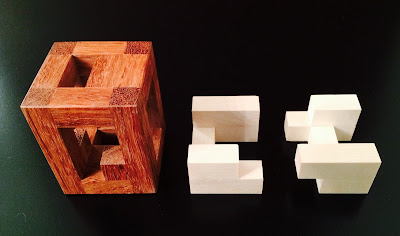The puzzle was 3D printed by Steve (mostly Steve fabricates all his puzzles using 3D printing) and measures 5.8cm all round. Its the same size as that of a standard Rubik's Cube. The cube itself is textured on four sides not only to make gripping easy but to give the puzzle some pattern. There is sufficient tolerance to allow the pieces to "twist" reasonably smoothly without jamming nor it being too loose.
For puzzlers who like cylindrical "burrs", this is a must have to add to any collection. A couple of puzzlers have lamented the fact that these puzzles are not made of wood....Don't we all wish they can be made of exotic woods. However, I am not sure if wood turning (or other methods of wood-working) can produce such designs into actual working copies. Granted 3D printed ones can't compare with the quality of their wooden counter-parts, but at least these designs have been realised into functioning copies for puzzlers to enjoy. And as far as I can tell, so far Derek has designed and Steve produced, everyone of this type of puzzle that have come onto the market.
Those interested to get a copy of Vapors can contact Steve Nicholls via his website here.































































































